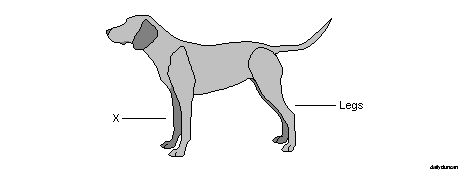Dogs are often called our four-legged friends, but this label is inaccurate in more ways than one. First of all, many dogs are not friendly. Each year, nearly 4.5 million Americans are bitten by dogs, and half of those are children. That means a child is bitten by a dog every 16 seconds in the United States alone. The other inaccuracy in this title has to do with the physical anatomy of canis lupus familiaris (the domestic dog).
According to the dictionary, a leg is defined as a limb used for support or mobility. Naturally this would imply that humans have two legs and dogs have four. But our understanding of what constitutes a leg varies depending on the species. Gorillas, for example, walk using all four limbs, yet most would agree that they have only two legs. Most contend that the front two limbs of a gorilla should be considered arms because they are used in much the same way that we use them: to forage for food, to use tools and to scratch ourselves. However, dogs use their front limbs for digging, climbing and adorably covering their faces, yet these appendages are somehow not awarded the title of arms. But if a dog’s front limbs aren’t arms, what are they and why?
A common understanding of the distinction between arms and legs is the idea that arms have hands. Proponents of this view would argue that a gorilla’s front limbs should be considered arms because they have hands with opposable thumbs, but there are many other creatures with hands that have thumbs, including the giant panda, the chameleon, the opossum and some species of reptiles, rats and frogs. So not only does the hand-arm theory imply that rats and frogs have arms, it also would mean that a gorilla has no legs at all because its feet have opposable toes as well. In addition to these complications, this understanding fails to address the fact that many animals, including the dog, have significant anatomical differences between the front and rear appendages.
There are yet others who subscribe to the if-it’s-not-a-leg-it’s-an-arm movement (IINALIAA), which implies just that: any limb not used for mobility is an arm. While this idea perfectly explains the anatomy of bipeds such has humans and kangaroos, it also implies that gorillas don’t have arms and that birds might actually have arms. Since this argument specifically tackles the issue of identifying arms among legs, it doesn’t effectively address limbs such as wings, which, while they aren’t legs, are used for mobility. In addition, it’s obvious to everyone that a gorilla’s front limbs are much more armish than a bird’s wings.
Each of these explanations falls short of satisfying our understanding of the difference between arms and legs, and so we have a problem. Both gorillas and dogs use all four limbs for mobility, have different front and rear appendages and use the front two for special functions, and yet we deny dogs arms. What’s not in dispute here is the nature and function of a leg – any child can tell that legs are used for walking. What is in dispute is what makes some legs arms.
To take a brief break from animals with controversial limbs, let’s take a look at a creature with an anatomy that we can all agree upon: the centipede. Centipedes are totally disgusting and possess anywhere between 20 and 300 identical limbs, each used solely for mobility and freaking people out. There’s no debate about whether any of these legs are actually arms because the only purpose of each limb is movement and all of them are the same – and that’s where the difference lies. When we inspect the anatomy of humans, gorillas and dogs, the one feature that they all share is an obvious design difference between the front and rear limbs. And not only is the form and function of each limb set unique, the structure of the joints that connects the limbs to the body is also different.
As illustrated above, dogs possess both a set of hips and a set of shoulders, and everyone knows that shoulders connect to arms. Also, if the front and rear limbs of these animals are so different, why should we give them the same name? If gorillas have arms, then arms can be used for mobility. And if kangaroos have arms, then arms don’t need hands with opposable thumbs. So if dogs have shoulders and if arms can be used for mobility and don’t require hands, then we’re left with only one conclusion: dogs must have arms.
The error lies in the false belief that an arm is defined by what it doesn’t do instead of what it does. A leg does not become an arm when it stops being used for mobility; a leg becomes an arm when starts being used for more than mobility. Just think of a panda laying on its back eating bamboo. Is it really using its legs to grab hold of the shoots and bring them up to its mouth? Of course not!
This new understanding of limbs is sure to make some people uncomfortable. After all, what about horses, hamsters, llamas and lemurs, seals, skunks, tigers and turtles? Surely the entire animal kingdom must be reexamined in order for their limbs to be properly classified. But just because a proposition implies a difficult solution, it doesn’t mean it’s incorrect. In fact, it’s likely evidence that the opposite is true.

